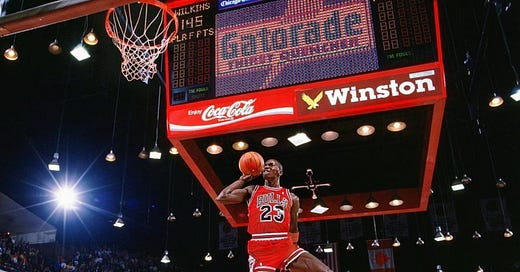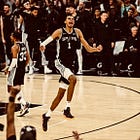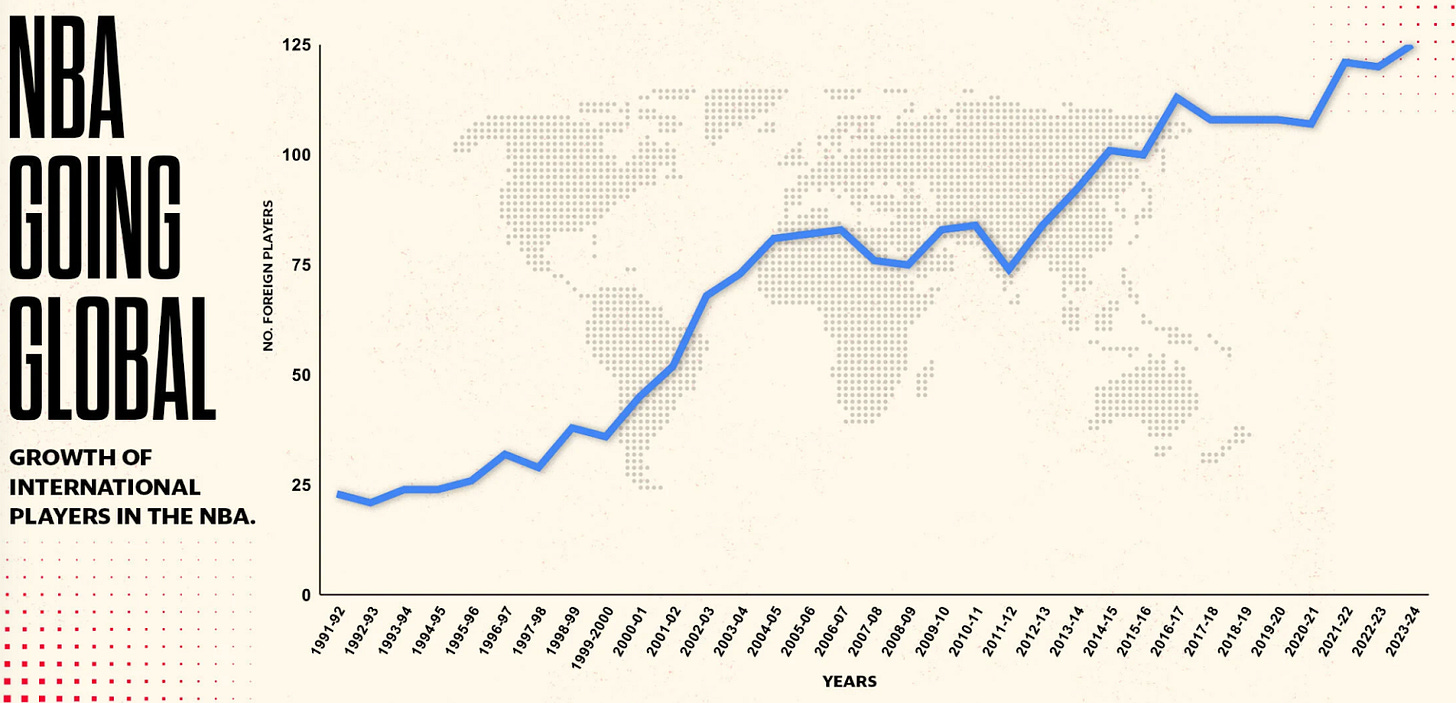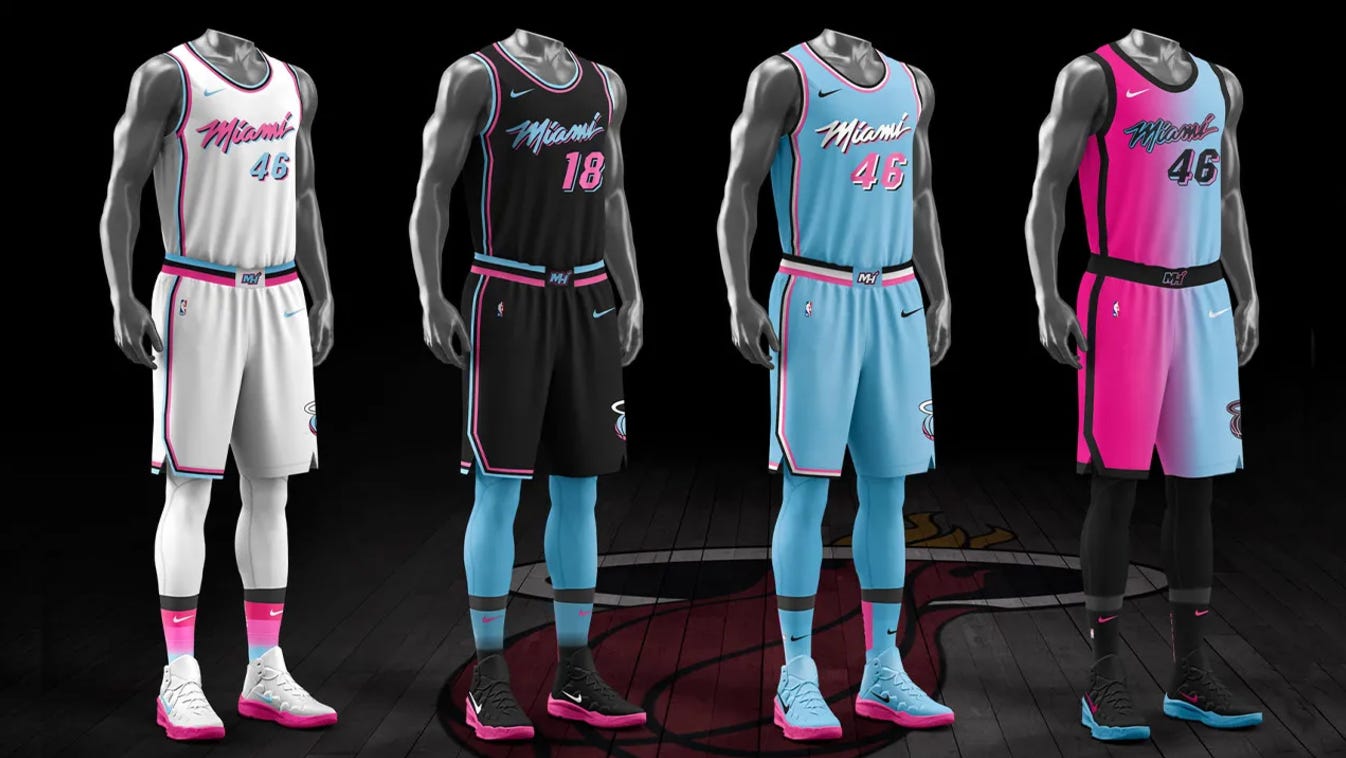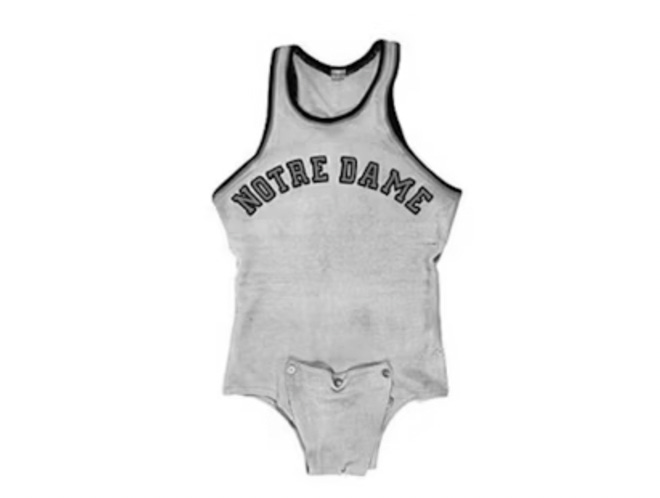Deion Sanders has said throughout his playing and coaching days:
“If you look good, you feel good. If you feel good, you play good. If you play good, they pay good.”
Though not the most grammatically correct, “look good, feel good, play good" is a catchy phrase. It’s a reminder of how tightly performance and confidence are woven together. It’s how athletes carry themselves. It isn’t about showing off, but showing up. It’s a signal: “I’m here, and I’m ready to put in work.”
So much of an athlete's swagger comes from the jersey and how they wear it—a statement piece, just like a Louis Vuitton bag compliments the outfit.
The NBA jersey has revolutionized how professional basketball players look, feel, and play. I explored this fun, interesting, and slightly unserious (you know if you read until the end) dive into the NBA jersey’s influence on and off the court.
Look Good
It’s hard to find something in sports that has as much influence on society's culture as an NBA jersey. The jersey has become more than something worn between the lines. Many outside the NBA wear the jersey as a fashion statement in the streets. Not only can it be used to support your favorite team or player, but it is now worn to represent a city, one’s own personality, or even your desired identity or beliefs.
Michael Rubin, the CEO of Fanatics, a major seller of sports jerseys, said they sold more Caitlin Clark jerseys on draft night than any player in any sport ever. Though not NBA, the sale of Clark’s jersey represents a cultural shift in sports to enable women's empowerment. It shows that it’s ok to compete hard as a woman athlete. Fans want to showcase that and look good doing it.
Wearing NBA jerseys by everyday people didn’t gain popularity until the rise of hip-hop culture in the 1990s. Rappers like Tupac and Jay-Z wore jerseys in music videos, during performances, and in everyday life. It was during this time that the NBA began pushing for international growth.
Michael Jordan, Shaquille O’Neal, and Allen Iverson were no longer just athletes—they were global celebrities. Just as young girls (and adults, let’s be honest) today want to wear the same clothing that Taylor Swift wears at The Eras Tour, trendsetters began wearing the jerseys of their favorite NBA players.
In the early 2000s, NBA jerseys became synonymous with pop culture. With clothing trends leaning more towards fitting like parachutes and NBA players putting their stamp on the fashion world, oversized NBA jerseys became a part of the trend.
Popular designers such as Mitchell & Ness brought back vintage jerseys, catering to nostalgia. The NBA partnered with designers like Virgil Abloh and Jerry Lorenzo, who incorporated basketball aesthetics into their streetwear and luxury collections.
Companies such as Nike also started producing alternative jerseys featuring city histories and culture, giving jerseys different meanings and making them more desirable for fans. Today, independent artists and creators who have become popular on social media have gone viral incorporating jerseys and sports logos into hand-stitched jackets, pants, and custom colorway shoes.
Because NBA jerseys have helped fans and cultural icons “look good,” they drive a large portion of NBA merchandise sales. Of the top seven sports jerseys ever sold, three are of NBA players—Michael Jordan, LeBron James, and Kobe Bryant. This is pretty incredible considering most of the world is soccer fans, and the NFL’s popularity outshines all sports in the United States. NBA jerseys have a cultural influence that other sports jerseys don’t.
Feel Good
Nowadays, jerseys are manufactured using the best technology for optimal athletic performance. It wasn’t always this way though. Before the days of the NBA, jerseys were made of wool, which believe it or not, was designed to be breathable. The jerseys buttoned up under the crotch like a baby onesie.
By the time the NBA was organized, polyester and nylon fabrics were used to make jerseys because players complained that the wool was too hot to play in (go figure). The shorts were short and the tops were designed similar to tracksuits. In the 1950s, players were required to wear belts with their satin shorts, though this was short-lived, as elastic waistbands replaced them in the 1960s.
The 60s is when style started to become a descriptor of NBA jerseys. Jerseys started to become more colorful, aligning with hippie culture. Jerseys began to be made with a pinhole mesh material. Players started wearing more accessories during this period too, which included long tube socks up to their knees and headbands to keep their long hair out of their face.
It wasn’t until 1987 that the style of shorts started to change. Michael Jordan requested the NBA jersey manufacturer, Champion, to make his shorts longer. The longer shorts though weren't for style, but convenience. Jordan wanted something to grab onto as he bent over during stoppages in play to catch his breath. Jordan’s request changed how shorts fit forever.
The late 90s and early 2000s saw jerseys transform from form-fitting to baggy. Today, shorts are a little shorter, and tops are a little more form-fitting. Some of this is due to Nike tailoring jerseys based on how players move and position themselves on the court. They even used digital body scans to improve breathability in places on the body that sweat the most. Jersey materials have also undergone another round of updates. Nike uses Dri-Fit and Cool-Dry materials for optimal comfort and performance.
Jersey designs now take on more complex color schemes due to printing technology, which allows for color gradients and complex patterns to be used. In every way, NBA jerseys have improved in function, style, and comfort to help athletes “feel good” as they play.
Play Good
Ok, now comes the fun and slightly unserious part. It’s not unheard of for non-fans of the game to choose their favorite team based on which jersey they like the most. It’s also not out of the question that players care about how they look wearing a jersey. It’s why when teams have jersey reveals for players and fans they are met with oohs and ahhs.
It’s also why players have negative reactions towards jerseys that don’t hit the mark (cough, jerseys with sleeves era). Just check out these reactions from NFL players when they were pranked with an ugly sweater jersey for their Christmas Day game. They care how they look!
So, for the sake of argument, let’s go out on a limb here and say that looking good is a prerequisite to “playing good.” I decided to analyze the primary color of each NBA championship team since the 1990 season and see what “impact” a team’s color has on performance. I know, this isn’t the reason why teams win, but it’s still a fun exercise.
What I found was that teams whose primary color is red, yellow, black, or green tend to overperform relative to expected championships whereas teams whose primary color is blue, orange, purple, or turquoise underperform. I found that many of the dynasties that took shape over the last 35 years tell a similar story as before the 1990s. So, if you are an NBA free agent reading this, now you know what the winning color combinations are.
In all seriousness, championships are largely driven by preferred markets, great team building, and exceptional talent on the court. However, there is something to be said about playing for a team with an iconic jersey, history, and aura.
The next time you slip on a jersey—whether to cheer on your favorite team or show off your style, remember, it's more than fabric. Jerseys are designed to help you look good, feel good, and play good.


